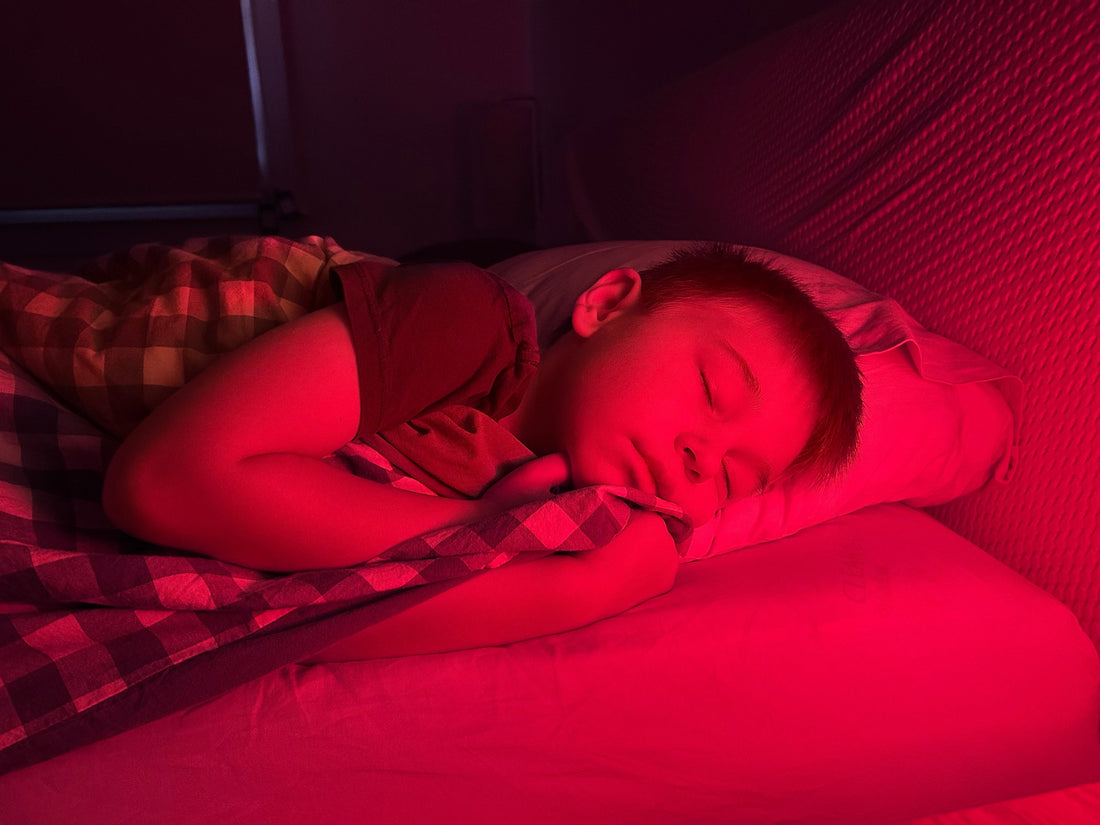
How to Create a Sleep Routine for Kids That Supports Better Sleep
Share
How to Create a Sleep Routine for Kids That Supports Better Sleep
Sleep is essential for children's growth, mood, learning, and emotional wellbeing. Yet today's environment - bright lights, screens, unpredictable routines - often works against natural sleep cycles and our circadian rhythms.
Gentle, thoughtful habits and a calming environment can help children build strong sleep skills that support them for life and achieve better sleep naturally.
Good sleep hygiene starts with small, thoughtful changes to light, sound, and routine. We know this not just from the research - but from our own family experience. Marty and I have implemented these small changes with our kids, and we've noticed a considerable shift.
Our children fall asleep earlier, settle more calmly, and their behaviour has become more balanced overall. We've even taught our three-year-olds that at night, we only use red and warm lights - no other colours. It's a small habit, but it makes a big difference for creating a healthy nighttime routine.
What Is Sleep Hygiene for Kids?
Sleep hygiene means creating daily habits and an environment that naturally support healthy sleep. Small changes to light, sound, comfort, and routine can make a big difference over time and can show you how to improve sleep gently, without overwhelm.
The Role of Light in Children's Sleep
Bright, cool-toned lights signal "daytime" to the brain, suppressing melatonin.
Warm, low-intensity lights like red night lights help gently cue the body for sleep.
Light and Mood
Studies show that evening light affects children's behaviour and mood.
- Bright or cool-toned light at night can delay sleep and contribute to overtiredness, crankiness, and emotional dysregulation.
- Warm, soft lighting protects natural sleep signals, helping your child wind down calmly.
Try lowering the lights - not just in the bedroom, but throughout the house - about 1-2 hours before bed to help the brain and body naturally prepare for sleep and build a strong sleep routine.
Sound and Sleep
Sound machines or white noise can help mask background disturbances and create a calming environment.
It’s important to know:
- Studies suggest that continuous, loud white noise all night can prevent the brain from fully entering deep, natural sleep stages.
- Use a sound machine with a timer to run for the first 1–2 sleep cycles (about 90 minutes to 2 hours).
- Keep sound machines running all night only if there is significant external noise, like living next to a busy road.
Creating a soft, steady sound environment during wind-down is a simple way to improve sleep without overstimulation.
Thermal Comfort Matters Too
Feeling too hot or too cold can wake children or prevent them from falling into deep sleep. In our home, we check on the boys not long after they've drifted off, as they all tend to run hot through the night. Adjusting blankets or pyjamas early helps keep them comfortable and sleeping soundly.
Kid’s Bedtime Thermal Comfort Checklist
- Keep the room cool - around 18-20°C
- Choose breathable bedding they love (cotton or light wool)
- Use a light set of pyjamas, not too many layers
- Check they're comfortable under the covers, not sweaty or cold
- Leave an extra light blanket within easy reach
- Stick to a calm, familiar nighttime routine to support relaxation
A comfortable body helps set the stage for deeper, more restorative sleep.
Creating a Soothing Bedtime Routine
Simple, predictable sleep routines help anchor a child’s natural sleep rhythm.
In our home, our evening routine starts as soon as the twins get home from daycare. We begin with a little play, followed by dinner and chatting about our day. We move into showers or baths, dim the lights throughout the house, and encourage quieter play.
When the kids move into quiet play, I use the time to tidy up the kitchen and pack away toys. It's a small habit that helps create a calmer space for everyone and sets the tone for a peaceful evening.
We usually finish with a little TV and cuddles. Our eldest often puts himself to bed when he feels ready, and the twins follow soon after. We also show the kids that we’re getting ready for bed too - putting our pyjamas on, speaking more quietly, and winding down alongside them, so they feel that the whole house is shifting into a calm, sleepy rhythm.
We’ve found that replacing noisy or exciting activities with softer, slower ones has made a noticeable difference in how easily our children settle into sleep.
Some of our favourite calm evening activities include:
- Drawing or colouring quietly – pencils or water colouring
- Reading a favourite bedtime story together under warm light
- Sharing quiet cuddles while watching a gentle TV show together. We love ABC Kids.
(We know screens aren’t ideal close to bedtime, as research suggests they can disrupt melatonin production. But when we do allow a little TV, we make it as sleep friendly as possible by dimming the screen brightness and lowering the volume.)
These small, simple activities are part of what make sleep routines for our 3-year-olds easier, calmer, and more natural.
Small Changes
Of course, no evening is perfect - there are still messy moments, busy nights, or times when everyone is overtired. And you don’t need a perfect system - calm, consistent habits are what matter most. Even small steps, like dimming the lights or using a sound machine with a timer, gently support better sleep.
Lighting Your Path to Better Sleep
By making small, mindful changes to light, sound, comfort, and bedtime routines, you can help your child develop sleep habits that will support them for life.
Warm night lights, gentle sound environments, and predictable routines make sleep feel natural, safe, and calming.
Create a calm sleep environment for your family - Somni Sleep is coming soon. Click the pop-up to sign up, and we’ll email you as soon as we launch.
